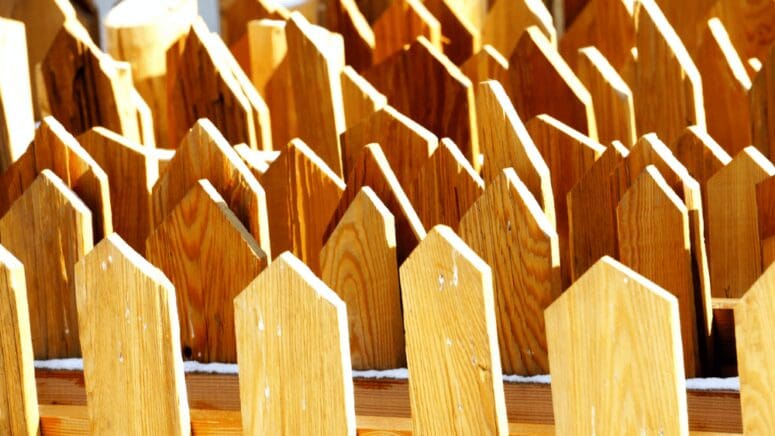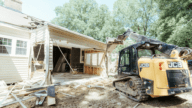The Price of Privacy: How Much Does It Cost to Build a Fence?
- Published on
- 8 min read
-
 Sam Dadofalza Associate EditorClose
Sam Dadofalza Associate EditorClose Sam Dadofalza Associate Editor
Sam Dadofalza Associate EditorSam Dadofalza is an associate editor at HomeLight, where she crafts insightful stories to guide homebuyers and sellers through the intricacies of real estate transactions. She has previously contributed to digital marketing firms and online business publications, honing her skills in creating engaging and informative content.
You’d love to host your family for an outdoor dinner, soak up some rays on the patio, or relax in the hot tub after a stressful day on a more regular basis. The trouble is … you feel like you’re on top of your neighbors or in a fishbowl surrounded by watchful eyes. A little privacy would make all the difference in the enjoyment of your yard, and create a respectful distance. You’d rather not let any more beautiful evenings go to waste, so how much does it cost to build a fence?
According to HomeAdvisor, the national average price for building a fence is $3,211, but the typical cost can be anywhere from $1,856 and $4,750. Yours could fall outside of that range, depending on the type of material, the size of your yard, any add-on features, and your contractor’s pricing structure.
Fence cost overview
The only way to know for sure how much a fence will set you back is to get a customized quote from a professional. But if you’re looking for a quick approximation, there are plenty of online sources that provide cost ranges for new fences. Let’s take a look at what a few of the most reputable home improvement cost aggregators on the web have to say:
Angi
- Average fence cost: $3,211
- Low-to-high cost range: $1,856 to $4,749
- Average cost per linear foot: $6 to $50
Methodology: Angi conducts a survey Angi conducts a survey of over 30,000 real customers to gather project cost data. This information is supported by research from reliable sources such as the U.S. Bureau of Labor Statistics, academic journals, market studies, and expert interviews.
Thumbtack
- Average fence cost: $3,999
- Low-to-high cost range: $1,676 to $7,357
- Average cost per linear foot: $23 to $57
Methodology: Thumbtack tracks the estimates that millions of people get from local professionals, and then shares those prices on its website.
HomeGuide
- Average fence cost: $1,800
- Average cost range: $1,500 – $3,000
- Average cost per linear foot: $20 to $60
Methodology: HomeGuide compiles the cost estimates that millions of homeowners get from local companies each year, and makes those prices available to the public.
What influences the cost of a fence?
Like any construction project, building a fence involves multiple decisions and options, all of which can affect the final price tag. Let’s take a look at some of the biggest cost drivers of building a fence.
Labor and installation
According to HomeAdvisor, labor to install a fence makes up about 50% of the overall project cost.
Ben Neely, a residential general contractor with Riverbend Homes, has installed many fences with his crew and has also used various local fencing companies when he’s been busy with other projects. In his estimation, the labor costs are usually around 30% to 40% of the customer’s overall cost.
Neely also points out that the type of material can affect labor costs. In his experience, aluminum fencing is the least labor-intensive and the quickest to install, which equates to less expense. Cedar privacy fences tend to be more labor-intensive — and thus more expensive — because of all the cutting and prep work that goes into the installation.
The layout and terrain of the yard can also impact the cost. For example, building a fence on a steep hillside will require more labor and cost more than building on a level lawn.
Materials
The type of fence you choose will have the biggest impact on the materials portion of your quote. According to a report by Grand View Research, metal (which includes aluminum and steel) is the most common fence material, followed by wood, plastic and composite, and concrete.
In Neely’s experience, the two most common materials used in residential fencing are iron and cedar. “When the community HOA allows, stained cedar privacy fences are the most popular for providing privacy for a backyard space,” he says. “Iron fencing is the most popular to install around a pool area.”
Justin Noss, president of All American Fence Erectors, a commercial and residential fencing company in California, says chain-link fences are the most common type of fence in his area because they are effective and affordable, followed by wooden fences and vinyl fences.
He estimates that chain-link, wood picket, and bamboo fences are some of the most affordable types, and some of the most expensive are vinyl, aluminum, and wrought iron.
Below is an overview of the average costs of the most common fence types, based on estimates from HomeAdvisor.
- National average: $3,220
- Average price range: $1,919 to $4,820
- Price per linear foot: $20 to $50
- National average: $4,141
- Average price range: 2,328 to $5,954
- Price per linear foot: $10 to $40
- National average: $4,494
- Average price range: $2,435 to $6,607
- Price per linear foot: Starts at $11
- National average: $3,159
- Average price range: $1,412 to $5,162
- Price per linear foot: $25 to $35
- National average: $2,387
- Average price range: 1,296 to $3,556
- Price per linear foot: $3 to $20
Gates
A gate can boost the aesthetics of a fence, but it also serves an important function. If you need to pass through to the other side of the fence, a gate offers convenient accessibility while still keeping the yard secure.
Some homeowners opt to install more than one gate for multiple access points, which is especially helpful for larger yards with longer fence stretches.
According to Noss, a fence gate usually costs anywhere from three to six times more per linear foot than the rest of the fence. As a rule of thumb, Neely takes the linear foot cost of the fence itself and multiplies that number by two times the gate opening.
For instance, if the per-linear foot cost to install the fence is $40 per foot and the gate opening is 4 feet wide, he calculates $40 x 8 feet (2x the fence opening) — or $320 total — for a close approximation.
Thumbtack also breaks down the average installation costs of some common types of gates:
| Type of Gate | Estimated Installation Cost |
| 4-foot chain-link swing gate | $100 |
| 28-foot chain-link wheeled gate | $800 to $1,000 |
| Single wood gate | $75 |
| Double wood gate | $150 |
| 4-foot vinyl gate | $300 to $400 |
| 8-foot vinyl double gate | $800 |
Removal of old fence
If you have an existing fence that needs to be dismantled and disposed of before the new one can be installed, that will drive up the total price. Noss says that in his California market, many fence installers will bill clients hourly for old fence removal.
“Rates average at around $50 to $90 per hour, and the time it takes to remove old fences and impacts can range from one hour to five or six,” he notes.
According to Angi, you can plan on spending around $3 to $5 per linear foot of fence that needs to be removed. On top of that, you must pay dumping fees.
The coronavirus premium
Laurie Cappuccio, a top Massachusetts real estate agent, has seen a surge in demand for fences among buyers since the onset of the pandemic. “As more people have been hunkered down at home, they’re more interested in having outdoor space and privacy,” she explains. “Also, there’s been an increase in people getting puppies and dogs, hence the need for more fences.”
Although the pandemic feels like a distant memory, its impact on construction product prices is still being felt years later. The surge in prices began soon after the pandemic took hold, and in 2021, lumber costs soared to nearly three times their pre-pandemic levels.
While lumber prices have since dropped from their peak, they remain high today. This trickled down to the construction of wood fences as well.
Fence project: A real-life cost example
Neely shared this actual quote he received from one of the fencing contractors he uses. Remember that your individual fence project will be quoted based on factors like your location, the type of fence material you choose, and how much fencing you’re putting in. So, use this quote for educational purposes only and as a point of reference:

How to save money on fence installation
Fencing can be a valuable investment, but it doesn’t have to break the bank. With a little planning and research, you can cut costs without sacrificing quality. Here are some tips to save money on your fence installation project:
- Choose cost-effective materials: Opt for vinyl or chain-link instead of pricier wood or wrought iron.
- DIY where possible: If you’re handy, consider installing it yourself or handling simpler tasks like clearing the area.
- Shop around: Get multiple quotes from contractors to find the best deal.
- Time the project right: Install during off-seasons when contractors may offer discounts.
- Buy in bulk: Purchasing materials in larger quantities could lower costs.
- Reuse materials: Salvage usable parts from existing fences or buy recycled materials.
- Keep it simple: Avoid decorative elements to minimize costs.
Tips to maximize your fence investment
According to experts, a fence should last 15 to 20 years with proper care. You can extend the life of your fence and get the most out of your investment with these recommended tips:
- Install strong posts. No matter what type of material you go with, your fence will only be as strong as your posts. Neely says to make sure the posts are made out of metal and mounted with concrete at least one foot into the ground.
- Collect at least three estimates. This will give you a broader range of bids to choose from, ensuring that you get the best combination of value and quality. The good thing is that for an exterior project like a fence, contractors can stop by and evaluate your yard and work up a quote without requiring you to be there at home.
- Ask the right questions. Will the company installing the fence take care of obtaining any necessary permits, checking the zoning regulations, and making sure no utility lines will interfere with digging? Will the fence be backed by a warranty? What is the timeline for installation?
- Protect your fence from the elements. If you decide to use a wood privacy fence, Neely recommends staining and sealing it within a week of installation to maximize the longevity of the wood and prevent natural decay.
- Check with your HOA. Before installation, check if the style and material you’ve chosen comply with any HOA regulations to prevent having to retrofit to the rules.
- Get a property survey first. Before your contract will start building, you’ll need to know your property lines. To do this, use your home’s plat (the map of your plot of land and boundaries) which should be part of your deed. If you don’t have it, head down to the county assessor’s office or call in a land surveyor to get you the right measurements.
Importance of value-adding fences
In addition to setting a clear physical boundary, fences help to keep pets and small children contained, provide safety around pools, deter would-be intruders, and officially mark your property lines. When you choose the right fence, the structure can also enhance the aesthetics of a home and make it more appealing to buyers when it comes time to sell.
At the end of the day — you’ll love the safety and privacy that a fence provides, and you will appreciate the marketability it adds to your property so long as you’ve chosen a suitable material and kept the fence in top condition over the years.
Header Image Source: (boris misevic / Unsplash)
- "Lumber Prices Continue to Tick Up, Raising Affordability Concerns," Builder (November 2024)
- "How Much Does Fence Installation Cost? [2025 Data]," Angi (December 2024)
- "Fence Installers on Thumbtack cost," Thumbtack (July 2024)
- "Fencing Market Size & Trends," Grand View Research
- "How Much Does Fence Installation Cost in 2025?," HomeAdvisor (December 2024)


